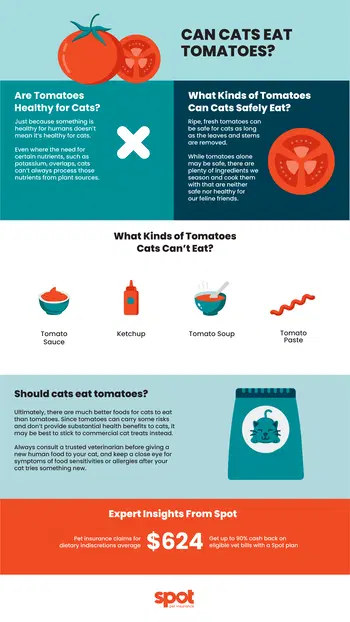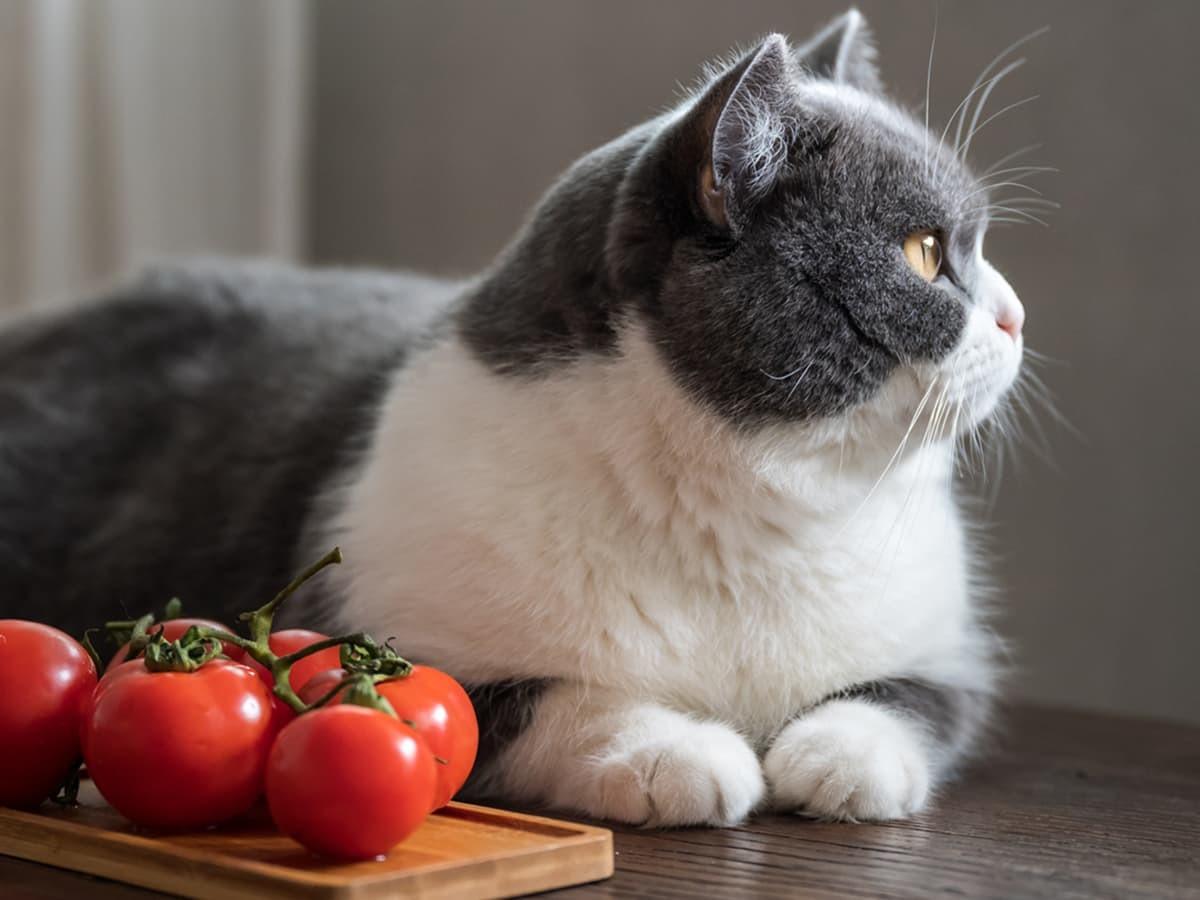Some cats are picky eaters and only come calling when the right food or treat is on the table. Others are curious and want a bite of everything you eat throughout your day.
For the curious cat, tomatoes are likely to be a target at some point. Many of the foods we love around the world include tomatoes of some kind.
Whether you’re eating sliced tomatoes on a sandwich, tomato sauce on pasta, or cherry tomatoes on a salad, there’s a good chance these red fruits will find their way into your kitchen and potentially into your cat’s stomach.
As pet parents, we’re responsible for keeping our pets safe and healthy, so it’s essential we stay informed on what foods are safe for cats. Today, Spot Pet Insurance continues our commitment to helping pet parents in this area.
This guide is all about tomatoes and whether cats can and should eat them. Are tomatoes healthy for cats like they are for humans? Are tomatoes toxic for cats? What kinds of tomatoes can cats eat? We’re answering all these questions and more.
Meet The Tomato: A Healthy Fruit For Humans
Tomato is a staple in the cuisine of many cultures around the world, yet many people are misled in terms of how to classify it.
The tomato is often called a vegetable. However, it is actually a fruit since it develops from a flower and contains seeds. It’s common to think of fruits exclusively as sweet treats, so many people struggle to accept tomato as a fruit since it is mostly used as a savory food.
Along with potatoes, eggplant, peppers, and even tobacco, we can classify tomatoes into the Nightshade family. These plants are best known for containing the alkaloid called solanine.1
Alkaloids are nitrogenous chemicals that affect the human body, but some also affect certain animals (such as cats). In the case of nightshades, solanine does indeed affect cats (as well as dogs and horses). We will talk more about how solanine affects cats a bit later.
Even though the tomato isn’t the vegetable many think it is, it’s still a very healthy food for humans, with nutritional qualities to rival any vegetable.
Tomatoes are most well-known as an excellent source of potassium and vitamin C. Other bountiful benefits include folate, vitamin K1, lycopene, and fiber.1
The main component of tomatoes, however, is water. This fruit is mostly water, with carbohydrates, fiber, and other minor components comprising the rest of its makeup.
Are Tomatoes Healthy For Cats?
Just because something is healthy for humans doesn’t mean it’s healthy for cats. As different species, we also have different nutritional needs and digestive systems.
Even where the need for certain nutrients, such as potassium, overlaps, cats can’t always process those nutrients from plant sources in the same way we can.
That’s because cats don’t need any plant foods. Cats are obligate carnivores, meaning their diet relies on meat (and eggs) pretty much entirely. Certain nutrients, such as taurine, are only found in meat and eggs. Cats can’t produce taurine, so they need to get it from their diet.2
Further, the feline digestive system isn’t set up for digesting plants. They lack the enzymes to process plants and take advantage of all the nutritional benefits within.
Your cat should already be on a complete, balanced diet of commercial cat food formulated by a certified nutrition professional. Such food provides all the nutrients a cat needs, so a tomato would be nothing more than a treat.
If your cat does happen to need additional nutrients, you should consult a trusted veterinarian. Human foods are not typically recommended for cats as a replacement for medical supplements.
Are Tomatoes Safe or Toxic For Cats?
Tomatoes are not considered toxic to cats, with a caveat.
The ripe, red fruit we humans know and love is generally safe for cats to consume — it shouldn't result in poisoning or sickness in most cats in small portions. However, the story is different with unripe, green tomatoes as well as the leaves and stem of the plant. These parts of a tomato plant are toxic to cats.
While the ripe fruit contains trace amounts of solanine (the alkaloid chemical in tomatoes that can be harmful to cats), the unripe fruit, the stem, and the leaves contain larger concentrations.
Solanine is also found in the same parts of potatoes and is toxic to cats, dogs, and horses. If your cat does become poisoned by solanine, symptoms include gastrointestinal upset (vomiting, diarrhea), lethargy, weakness, and sometimes confusion.
Thankfully, a tiny amount of solanine isn’t likely to result in toxicity. Most cats could eat some leaves or part of an unripe tomato and not become sick. Nonetheless, solanine should be avoided.3
What Kinds Of Tomatoes Can Cats Safely Eat?
Ripe, fresh tomatoes can be safe for cats as long as the leaves and stems are removed. How about cooked tomatoes, tomato sauce, or tomato paste? While tomatoes alone may be safe, there are plenty of ingredients we season and cook them with that are neither safe nor healthy for our feline friends.
The most common offender is salt. Salt can be toxic to many pets, including cats.
Salt poisoning can lead to signs of gastrointestinal upset, including vomiting and diarrhea. Reduced appetite, excessive thirst, excessive urination, lack of energy (lethargy), and lack of coordination can also occur. Tremors, seizures, and comas are sometimes seen in more severe cases, which could even lead to death.4
Be wary of tomato sauce, ketchup, tomato soup, tomato paste, and similar by-products, as they almost always include high amounts of salt, especially when bought from the supermarket.
Pet parents should also avoid added sugars, which cats can’t efficiently break down. These simple carbs could lead to weight management issues, diabetes, and the conditions that often follow, such as arthritis and dental issues.
In products that are labeled sugar-free, such as certain ketchups, an artificial sweetener called xylitol is often used. Xylitol is highly toxic for pets and should be kept away from cats.
Do Cats Like Tomatoes?
These questions about health and safety are important but irrelevant in the face of a cat that doesn’t even want to eat tomatoes. Frankly, cats tend to be picky eaters more often than not, and there’s a scientific explanation.
Cats have a vastly smaller range of taste senses than humans and dogs. To put things in a quantifiable perspective, humans have around 9000 taste buds, dogs around 1700, and cats, about 470.5
Additionally, certain tastes are absent from cat sensation, most notably sweetness. Although tomatoes are often used in savory dishes, the fruit is still sweet. Since cats can’t even detect that quality when they eat a tomato, your curious cat likely won’t be interested in another bite after their first try.

Expert Insights From Spot
While sharing our favorite foods with our pets can be tempting, it's important to remember that not all human foods are safe for cats. Spot's internal data shows that pet insurance claims for dietary indiscretions average $642*, highlighting the importance of caution and research before sharing snacks with your pet.
Conclusion: Should Cats Eat Tomatoes?
Ultimately, there are much better foods for cats to eat than tomatoes. Since tomatoes can carry some risks and don’t provide substantial health benefits to cats, it may be best to stick to commercial cat treats instead.
Always consult a trusted veterinarian before giving a new human food to your cat, and keep a close eye for symptoms of food sensitivities or allergies after your cat tries something new.
As always, we’re committed to helping pet parents along their journey every step of the way. Check out our Spot Pet Insurance Blog for more helpful resources like this one, and get a quote today to learn more about pet insurance and see if we could be a good fit for you!

I've had the privilege of immersing myself in the realm of pet safety. As the owner of an energetic mini golden doodle, I know just how stressful being a pet owner can be. I am dedicated to ensuring our beloved pets enjoy a life brimming with good health.
*Jan 2019 to Aug 2024 Spot Pet Insurance Services, LLC claims data.
Koschalk, Katie. "Can Cats Eat Tomatoes?" Chewy, 30 Apr. 2025, https://www.chewy.com/education/cat/food-and-nutrition/can-cats-eat-tomatoes.
Weir, Malcolm. "Taurine in Cats." VCA Animal Hospitals, n.d., https://vcahospitals.com/know-your-pet/taurine-in-cats.
Miller, Sarah. "Is It Normal for My Cat To Eat Tomatoes?" The Dog People by Rover, n.d., https://www.rover.com/blog/can-cats-eat-tomatoes/.
"Salt Toxicity to Pets." Pet Poison Helpline, n.d., https://www.petpoisonhelpline.com/poison/salt/.
Gray, Elizabeth. "How Do Cats Taste Their Food?" Catster, 19 Jun. 2025, https://www.catster.com/lifestyle/how-do-cats-taste/.
The information presented in this article is for educational and informational purposes only and does not constitute or substitute for the advice of your veterinarian.












